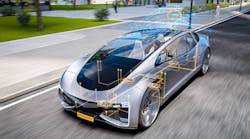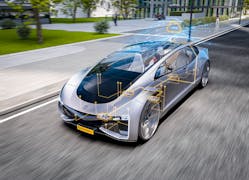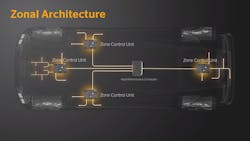What you'll learn:
- What is a zone control unit?
- The central role of Infineon's AURIX TC4x in Continental's ZCU platform.
- A look at RRAM technology introduced by Infineon and TSMC for the automotive domain.
All major tech players, companies from other industries, and startups whose names we’re just learning are working on some or all of the new major building blocks of the automotive future. Oftentimes, together with partners.
For example, Continental has developed a modular platform for automotive architecture using Infineon's AURIX TC4x microcontroller. The AURIX TC4x family of 28-nm MCUs targets e-mobility, automotive driver-assistance systems (ADAS), electrical/electronics (E/E) architectures, and artificial-intelligence (AI) applications.
The MCU features the 32-bit TriCore 1.8, along with scalable performance enhancements from the AURIX accelerator suite. The new scalable family provides an upward migration path from Infineon’s AURIXTC3x MCU family.
This next-generation AURIX increases computing capabilities with a SIMD vector DSP called a parallel processing unit (PPU). The PPU has advantages over traditional CPUs in relation to matrix operation acceleration, data processing, neural-network-based algorithms, and high-speed control implementations. The scalable family concept allows for a common software architecture said to enable significant platform software savings.
Streamlining with ZCUs
Continental is collaborating with Infineon in the development of this server-based vehicle architecture. The goal is an organized E/E architecture with central high-performance computers (HPCs) and a few, powerful zone control units (ZCUs) instead of up to a hundred or more individual control units, as has been the case.
Where individual functions or functional areas were previously integrated into the vehicle in separate control units, new thinking is now being applied. The new ZCUs consolidate vehicle functions in physical zones close to the sensors and actuators, forming the middle layer between the server level of the HPCs and the individual sensors and actuators. This ensures intelligent task distribution between all levels.
ZCUs reduce vehicle network complexity as well as costs by supporting centralized architectures and the increasing separation of software and hardware. Moreover, this is a prerequisite for continuous updates, improvements, and function deployment services to support the transformation toward the software-defined vehicle.
Among other things, AURIX TC4x was designed for usage in ZCUs and HPCs, focusing on applications such as radar, chassis, safety, and powertrain/electrification. Thanks to special storage technology in the AURIX TC4, the vehicle software initially is on standby. As soon as the vehicle is started, functions such as parking assistance, air conditioning, heating, and suspension are ready within fractions of a second.
With its platform approach, Continental is supporting the different requirements of automobile manufacturers. By individually configuring the number of HPCs and ZCUs, how they interact, and how they’re arranged in the vehicle, automakers can individually tailor their architecture to their needs.
"With our new architecture solution, we are making the vehicle fit for the future," said Gilles Mabire, CTO of Continental Automotive. “The growing variety of vehicle functions requires more and more computing power and increasingly complex software applications. Continental's new architecture is paving the way for the software-defined vehicle. The cooperation with Infineon is an essential step in realizing this development quickly for our customers. Thanks to our platform strategy, proven application software can be used in new vehicle models, for instance. As a result, the time-consuming validation effort is significantly reduced. New functionalities can be brought into serial production much faster.”
How Does the ZCU Platform Work?
The ZCU platform forms the middle level of the electric/electronics architecture between the server level (HPC) and the base level with numerous sensors and actuators. Data streams from different vehicle domains merge in the ZCUs. The data will then be processed and passed on to the HPCs as the top control level via secure Ethernet connections. Conversely, the zone control units act as a coordination point for executing commands from the server level.
The use of ZCUs is said by Continental and Infineon to be the next decisive step toward a software-defined vehicle. For Continental, a first major step was the development and delivery of an HPC for the electric-vehicle models ID.3 and ID.4 from Volkswagen. In the E/E architecture of the future, a ZCU will bundle all electronic and electrical connections in a local section of the vehicle.
For instance, ZCUs take over all control, data, and communication management tasks in the vehicle from areas at the front right, front left, and rear. Bundling the software components centrally will thereby increase cybersecurity.
The AURIX TC4x product family puts a focus on state-of-the-art cybersecurity functions, developed according to the ISO/SAE 21434-certified process. Among other things, the cybersecurity concept of the AURIX TC4x supports post-quantum processes. This strengthens protection against quantum-computer attacks, which pose a threat to the cryptographic methods currently in use.
Joint Introduction of RRAM Tech
A key element of the new microcontroller series is Infineon’s resistive random-access memory (RRAM) technology. Embedded flash microcontrollers have been the main building blocks of automotive electronic control units (ECUs) since the introduction of the first engine-management systems. They’re essential components for clean, safe, and smart cars, finding their way into propulsion systems, vehicle dynamics control, driver assistance, and body applications. They enable major innovations in the automotive space with regards to electrification, new E/E architectures, and automated driving.
Currently, the majority of MCU families in the market are based on embedded flash-memory technology. RRAM is a next step in embedded memories that allows for further scaling to 28 nm and beyond.
TSMC and Infineon successfully created the basis for introduction of RRAM in the automotive domain. It will put AURIX MCUs on a broader technology and supply basis. RRAM offers high disturbance immunity and enables bit-wise writing without the need to erase. Endurance and data-retention performance is comparable to flash technology.
“AURIX TC3x is well-established as a first-choice automotive microcontroller in many applications domains,” said Thomas Boehm, Infineon Senior Vice President and General Manager of Automotive Microcontrollers. “AURIX TC4x, based on TSMC’s Resistive RAM technology, further expands this with increased ASIL-D performance, artificial-intelligence capabilities, and the latest networking interfaces, including 10BASE-T1S Ethernet [a technology that provides a 10-Mb/s transmission that can include up to at least eight transceiver nodes] and CAN-XL. RRAM technology creates a significant potential for performance expansion, power-consumption reduction, and cost improvement.”
AURIX TC4x performance is boosted by the latest trends in virtualization, security, and networking features to better enable software-defined vehicles and new E/E architectures. This technology is already used successfully in chip cards, for example, when doing cashless payments and for secure authentication.
With RRAM technology, when a vehicle is started, functions like parking assistance, air conditioning, heating, and suspension are available within fractions of a second. Thanks to the AURIX TC4x architecture, essential software programs are almost constantly on standby. In addition, AURIX TC4x enables significantly faster and more secure over-the-air updates of software components.
The AURIX TC4x family meets the requirements for functional safety up to ASIL D, in accordance with the ISO26262 standard. Moreover, the family includes network accelerators ("routing accelerators") to relieve Ethernet and CAN communication,
“Our new vehicle architecture, consisting of a few powerful zone control units and high-performance computers, simplifies the wiring harness substantially. It saves weight and energy,” said Jean-Francois Tarabbia, Head of the Business Unit Architecture and Networking at Continental. “Thanks to a clear division of tasks in the organized vehicle electronics, the separation of hardware and software, and lastly, the necessary standardization of interfaces, the growing complexity and an almost exploding scope of software inside the vehicle can be managed in a much better way."


